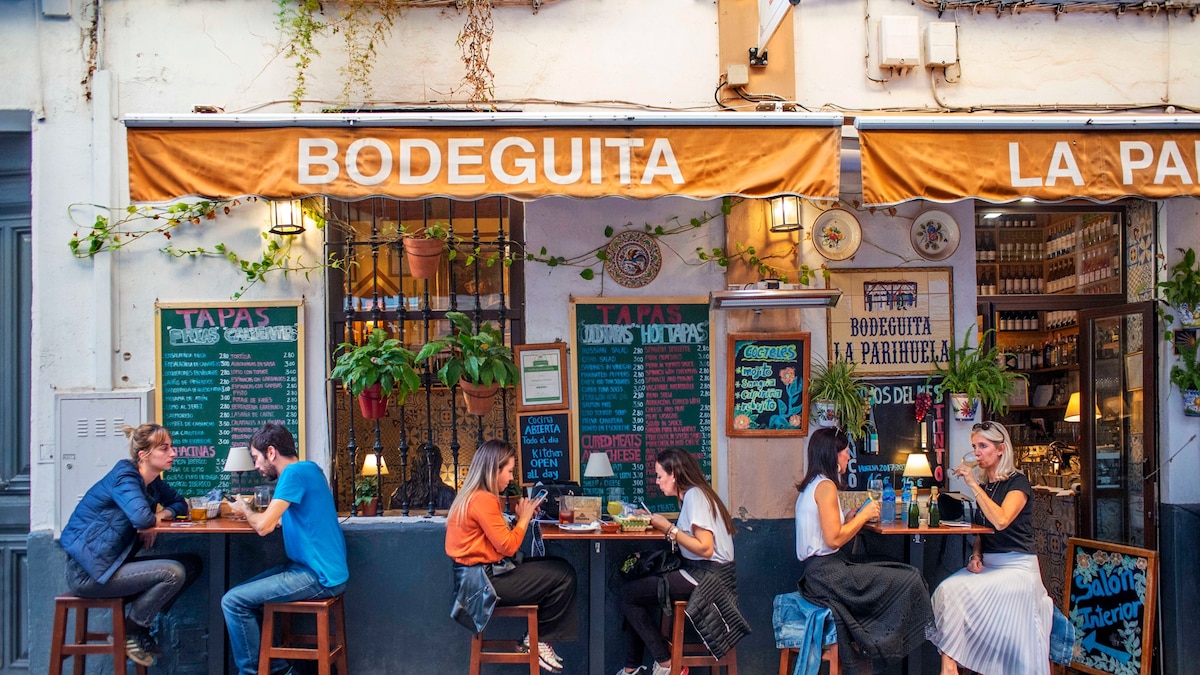Now Reading: This Spanish dining tradition is one of its best-kept secrets
-
01
This Spanish dining tradition is one of its best-kept secrets
This Spanish dining tradition is one of its best-kept secrets

It’s easy to spot when lunch has arrived in Spain. Shops, businesses, and schools shut their doors. Crowds begin to gather, spilling onto sidewalks, and packing into bars and restaurants in search of a good meal. While most visitors flock to the nearest plaza patio drawn in by signs for paella and sangria, most locals are settling into their favorite restaurants for one of Spain’s most beloved food traditions—menú del día.
Menú del día, or menu of the day, is a rotating three-course meal offered at an affordable price and can be found in restaurants all across the country. While some savvy travelers know of this dining secret, it mostly remains a locally loved tradition that visitors overlook.
The history of Spain’s menu of the day
Menú del día was born in the Franco regime. In 1965, General Francisco Franco passed a law requiring all restaurants to offer a fixed-price tourist menu that included three courses and a drink. The goal was to create an affordable lunch option and boost tourism.
The program worked. According to a study conducted by PubMed Central, Spain went from having 5.4 million visitors in 1960 to over 20 million by the end of the decade. It remains a tourist-driven incentive; however, over the years, it became a dining staple for locals as well.
The fixed menu, which typically costs between 10 and 16 euros depending on where you’re dining, includes a starter, main course, and dessert. It also comes with one drink either wine, beer, coffee, a soft drink, or water.
Given the low fixed rate, restaurateurs have to get creative. Most build their daily offerings around the cheapest, fresh ingredients they can get from local purveyors. The meals are simple by nature, but they’re always filling and satisfying.

Main courses tend to be heartier, often centered around meat or seafood.
Photograph by Alexander Spatari via Getty Images
What to expect
The menu typically has three to four options for each course: primer plato (starter), segundo plato (main course), and postre (dessert). You make your selection for all three courses upon ordering and specify the drink you want.
For the starter, you might find fideuà, a short-cut noodle dish similar to paella; huevos revueltos, scrambled eggs with mushrooms, asparagus or morcilla (blood sausage); or a chilled soup like salmorejo or gazpacho.
Main courses tend to be heartier, often centered around meat or seafood. You might see pork loin in a creamy blue cheese sauce, beef cheeks braised in red wine, or a fish fillet finished with a light lemon and garlic sauce.
Fresh fruit is the most common dessert in Spain. But occasionally, you’ll find options like ice cream, a chocolate or apple tart, rice pudding, or even a wedge of cheese drizzled with honey.
Don’t be surprised if you receive a whole bottle of wine when two or more people order the menú del día. House wine is often served in an individual porrón, a uniquely shaped glass pitcher traditionally poured straight into your mouth, if you’re brave enough to try.
That said, the dishes don’t always stick to traditional Spanish cuisine. International restaurants serving everything from sushi and ramen to pasta often offer a three-course menú del día built around their usual fare.
Where to find the menu of the day in Spain
Virtually every city and province across the country offers menú del día, although it’s no longer required by law. The European Directive 2006/123/CE revised tourism laws in the European Union to encourage free-market practices. This eliminated the legal requirement for Spanish restaurants to offer a fixed-price tourist menu, giving regions and individual establishments the freedom to decide whether to continue the tradition.
Today, menú del día is becoming less common due to thin profit margins for restaurant owners. Still, many spots, especially in larger cities like Seville, Málaga, Barcelona, and Madrid, continue to serve it.
The catch, though, is that it is only available on weekdays from about 1:30 to 3:30 p.m. It’s never offered on the weekend. After 4 p.m., most restaurants close to prep for dinner and won’t open again until around 8 or 9 p.m.
Unfortunately, there’s no foolproof way to know if a restaurant offers menú del día without stopping by or calling ahead. Your best bet is to keep an eye out for chalkboards or printed signs advertising a fixed-price lunch as you wander the city.
Menú del día shouldn’t be a well-kept secret reserved for locals. With so many restaurants offering it and the incredible value it provides for a high-quality, freshly made meal—it’s something more travelers should know about and seek out.
Liz Brumer-Smith is a Florida-based freelance writer and travel creator behind the channel Eat See TV. In 2017, she and her husband hit the road full-time in their RV with their two cats, exploring North America and documenting their adventures on YouTube and their blog. Today, Liz shares stories of food, culture, and destinations around the globe.























